Manx Electric Railway
| Manx Electric Railway | |
|---|---|
 | |
|
Cars, shed and sign at Derby Castle | |
| Operation | |
| Owner | Isle of Man Heritage Railways |
| Technical | |
| Line length | 17 mi (27 km) |
| Track gauge | 3 ft (914 mm) |
| Electrification | 550 V DC |
| Manx Electric Railway | ||||||||||||||||||||||||||||||||||||||||||||||||||||||||||||||||||||||||||||||||||||||||||||||||||||||||||||||||||||||||||||||||||||||||||||||||||||||||||
|---|---|---|---|---|---|---|---|---|---|---|---|---|---|---|---|---|---|---|---|---|---|---|---|---|---|---|---|---|---|---|---|---|---|---|---|---|---|---|---|---|---|---|---|---|---|---|---|---|---|---|---|---|---|---|---|---|---|---|---|---|---|---|---|---|---|---|---|---|---|---|---|---|---|---|---|---|---|---|---|---|---|---|---|---|---|---|---|---|---|---|---|---|---|---|---|---|---|---|---|---|---|---|---|---|---|---|---|---|---|---|---|---|---|---|---|---|---|---|---|---|---|---|---|---|---|---|---|---|---|---|---|---|---|---|---|---|---|---|---|---|---|---|---|---|---|---|---|---|---|---|---|---|---|---|
Legend | ||||||||||||||||||||||||||||||||||||||||||||||||||||||||||||||||||||||||||||||||||||||||||||||||||||||||||||||||||||||||||||||||||||||||||||||||||||||||||
| ||||||||||||||||||||||||||||||||||||||||||||||||||||||||||||||||||||||||||||||||||||||||||||||||||||||||||||||||||||||||||||||||||||||||||||||||||||||||||
The Manx Electric Railway is an electric interurban tramway connecting Douglas, Laxey and Ramsey in the Isle of Man. It connects with the Douglas Bay Horse Tramway at its southern terminus at Derby Castle at the northern end of the promenade in Douglas, and with the Snaefell Mountain Railway at Laxey. The line is undulating and passes through areas of scenic beauty. Many visitors take an excursion on the trams.
Service and routing
The line runs on roadside reservation for the first few miles from Douglas and then on segregated track through the countryside for most of the route to Ramsey. The line is 3 ft (914 mm) narrow gauge and is 17 miles (27.4 km) long. It is largely segregated from road traffic, running on double track on roadside reservation or private right-of-way, and is electrified using overhead line at 550 volts direct current. Initially the trams used pairs of Hopkinson bow collectors (still used on the Snaefell Mountain Railway, owing to its dependability in strong winds on the mountain) but by the turn of the 20th century they were fitted with trolley poles, the method still employed. Originally the electricity was generated by the railway's own power stations, now via the island's grid by the Manx Electricity Authority. Having always operated year round, the winter service is much less frequent than in summer, and has been intermittently dropped from schedules in recent years to allow substantial investment in infrastructure, including relaying longer stretches of track.
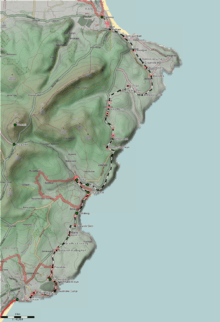
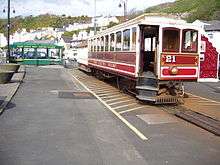
Originally the service was provided by about 24 trams and the same number of trailers: the earliest date from 1893 and almost all are pre-1910. Two of the three cars that opened the line in 1893 are still in use, and are the oldest electric trams at work on their original line in the world. The design pre-dates any consensus on design, and they have distinctive boxy bodies. Most services are operated by a motor car towing a single trailer, although later cars can haul two trailers. This has never been common practice (in recent years this has included in a few "special" services as part of the long-running series of events) although it was not uncommon for cars to haul a box-van for freight and, until 1975, a mail van. In September 1975 the line was closed between Laxey and Ramsey and the contract with the Post Office was lost, but in 1977 the Ramsey section was reopened. Since then a limited winter service has operated on weekdays, suspended in 1998 as an economy measure. The line operates a seasonal timetable with services terminating at Laxey or Ramsey, with some short workings in connection with the Groudle Glen Railway in peak season, and limited evening operation as far as Laxey in peak season to tie in with evening services on the Snaefell Mountain Railway, which since 2009 has provided a weekly Sunset Dinner service including a meal at the summit. The possibility of a limited evening service to Ramsey has been considered in recent times and trams are sometimes chartered during summer for enthusiasts' excursions.
Ownership
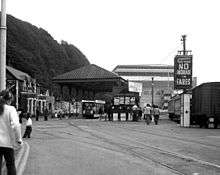
The first section, from the northern end of the promenade at Douglas to Groudle Glen, opened in 1893, to Laxey in 1894 (the Snaefell Mountain Railway opened the following year from Laxey) and Ramsey in 1899. The first section was built by Douglas Bay Estates Ltd., and by 1894 the tramway had been acquired by the Douglas & Laxey Electric Tramway Co. Ltd, which changed its name to the Isle of Man Tramways & Electric Power Co. Ltd (I.o.M.T.&.E.P.) the same year. The I.o.M.T.&.E.P. went into liquidation in 1900 as a consequence of a banking collapse. The line was sold by the liquidator to the newly formed Manx Electric Railway Co. Ltd, which took over in 1902. By the late 1950s the company was in financial difficulties, and in 1957 it was acquired by the Isle of Man Government (which carried out a similar move two decades later to save the Isle of Man Railway). A nationalisation livery of green and white was applied to some trams and trailers for a limited time, though this was unpopular and later dropped. A government Board was formed to manage the line and the Snaefell Mountain Railway, and still does so after various changes of title from the original Manx Electric Railway Board to Isle of Man Passenger Transport Board, now Isle of Man Heritage Railways (the word heritage being added in 2009). This is a division of the Department of Community, Culture & Leisure of the Isle of Man Government, and is also operates the island's buses as Bus Vannin.
Railway stations
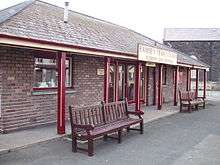
There are several intermediate railway stations, with Groudle Glen, Laxey, Dhoon Glen, Cornaa and Ballaglass Glen shown in timetables. The official stopping points usually have a basic waiting shelter (more recent additions have been modern bus shelters), and there are "unofficial" stopping points that sometimes have "request stop" notices but not nameboards or other passenger facilities. Several in the more rural areas have the name of the nearby farm or farmer; these are most prevalent in the northern section with names such as Rome's Crossing, Watson's Crossing and Dhoon Farm, but none of these has carried its name. Some stopping points are known by their nearest pole number, numbered 1 to 1,904 from Derby Castle to Ramsey. Trams stop within reason at any point where it is safe to do so, except where the line runs parallel to a main road. The majority of the line as far as Baldrine railway station runs in this way, as does the approach to Ramsey. These sections were originally toll roads, built at the same time as the line.
Tramcars and trailers

The line is in many ways unique, not least because it still operates entirely with its original rolling stock, except winter saloon 22, which was completely rebuilt following a fire in 1992 after which the coachwork was no longer usable. A considerable amount of stock was lost in a disastrous fire at Laxey in 1930, but other than this all the original stock remains. In recent times the storage of excess stock has become something of a political "hot potato" with several vehicles stored off-site, with all of these items returning in November 2009 but still in store, requiring considerable attention before returning to traffic in many cases. The line belongs to the Isle of Man Government as part of the Department of Community, Culture & Leisure, which does not see the requirement to retain unused stock that has no potential use or long-term storage place on the railway. The line has Lisbon tram purchased in 1999, but this has never seen use due to clearance difficulties (it was used as a passenger waiting shelter for a spell). It is no longer on the railway, but remains on the island.
The following trams were in passenger service in the 2010 season, with the mainstay of the services being winter saloons or tunnel cars. Original tramcars 1 and 2 are both operational but are not usually in day-to-day use, tunnel cars 5 and 6 see use in peak summer season and illuminated car 9 (also a member of this class) is used in conjunction with the evening services on the Groudle Glen Railway in July and August. Winter saloons 19-22 operate the core timetable. There are servicable open toastracks, numbers 26, 32 and 33 (the last two being the most powerful on the line). Many other cars remain in the railway's possession but out of service and in some cases off-site. Trailers used include lightweight trailers 37 and 49, bulkheads 40-48 which usually accompany the winter saloons, lightweight trailer 51, converted disabled saloon 56, closed saloons 57 and 58 and 61-62. The Royal Saloon, No. 59, makes rare public appearances. As part of the annual transport festival car 32 occasionally operates a special evening service hauling two trailers, an unusual occurrence despite the later cars being built with the capability to operate in this way. Car 7 was relegated to permanent way duties for a number of years but was restored for return to traffic in 2011, locomotive 23 is privately owned, car 34 (previously No. 7 Maria on the Snaefell Mountain Railway and regauged) is undergoing maintenance, and other cars receive remedial attention as and when time and funding allows.
Temporary closures

The section between Laxey Station and Ramsey has been controversially closed twice: in 1977, but owing to public outcry it was reopened with due ceremony later in the year; and in summer 2008, after a consultancy report commissioned by the Isle of Man Government exposed critical failings in the permanent way, deeming it unsuitable for passenger service in the near future.[1] The island's parliament, Tynwald, agreed to spend nearly £5 million for track replacement in July–September, allowing trams to run on one track,[2] according to a news report. Manx authorities were considering vintage buses as a replacement during the closure, reports previously stated. The resignation of the Tourism and Leisure Minister Adrian Earnshaw was called for by enthusiasts and Chief Minister Tony Brown ordered an urgent review of the closure decision. He also ordered an independent inquiry into how the track had been allowed to get into such a state.[3] In 2009 the full line operated continuously and has continued to do so since the beginning of the next season at Easter, with no rail-related incidents affecting services. Until 1998 the line operated a winter service but since then has run seasonally, usually between March and the beginning of November, though this can vary from season to season.
Incidents
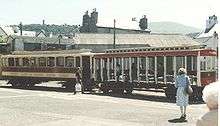
Owing to the number of open and ungated level crossings there are minor collisions, and these are reported in the local press. These have become more commonplace but are usually minor; warning signage to alert motorists that trams are operating has been erected at the start of each season in recent times, but incidents still occur. There are many occupation crossings, some with restricted visibility for motorists. The most recent incident took place on Monday, 27 July 2009, when a vehicle carrying a mechanical excavator came into contact with the overhead wires supplying power to both the line and the Snaefell Mountain Railway at a busy road crossing in Laxey; there were no injuries. Police and the line's electrical engineering crews attended the scene, the report also said. It did not indicate what damage had occurred. Service resumed the next day after temporary repairs to the overhead lines, which were permanently repaired over the subsequent couple of weeks. An investigation into the incident was scheduled to take place later.[4]
About 70 metres of copper overhead wire were stolen between late January and 14 February 2012 between Laxey and Ramsey. Police recovered the stolen material.[5]
On 7 July 2015, trailer 58 suffered a serious derailment on a relatively new crossover just north of Laxey Station, toppling onto its side. Services were suspended between Laxey and Ramsey.[6] A complex operation was undertaken to lift the trailer back upright. It required a road closure, removal of overhead line equipment and a large crane. The re-railed trailer was then moved by tractor to Laxey Station.[7]
See also
- British narrow gauge railways
- Heritage railways in the Isle of Man
- Maley & Taunton
- Transport on the Isle of Man
- List of tram and light rail transit systems
References
- ↑ "Manx Electric Railway and Steam Railway Condition Reports".
- ↑ Jones, Robin (10 April – 7 May 2008). "Closed Manx Electric section to reopen in July". Heritage Railway magazine. No. 110. Horncastle, Lincolnshire: Mortons Media Group Ltd. p. 32.
- ↑ Jones, Robin (13 March – 9 April 2008). ""Resign" calls after minister shuts Manx Electric line". Heritage Railway magazine. No. 109. Horncastle, Lincolnshire: Mortons Media Group Ltd. p. 24.
- ↑ Manx Independent page3 dated 31 July 2009 Isle of Man Newspapers ISSN 1358-4391
- ↑ http://www.manx.net/isle-of-man-news/4584/theft-of-manx-electric-railway-overhead-cable
- ↑ "Derailed tram causes delays on Manx Electric Railway". BBC News Online. Retrieved 7 July 2015.
- ↑ https://mers.org.im/blog/articles/view/id/153/The%20Recovery%20of%20Trailer%2058
Sources
- Goodwyn, A.M. (1976) Is This Any Way To Run A Railway ? - The story of the Manx Electric Railway since 1956., Manx Electric Railway Society website, accessed 24 November 2006
- Goodwyn, M., (1993) Manx Electric, Platform 5 Publishing, ISBN 1-872524-52-4
- Heavyside, Tom (2010). Douglas – Laxey – Ramsey: including the Groudle Glen Railway. Narrow Gauge Branch Lines series. Midhurst, West Sussex, UK: Middleton Press. ISBN 9781906008758.
- Hendry, R., (1993), Rails in the Isle of Man: A colour celebration, Midland Publishing Limited, ISBN 1-85780-009-5
External links
| Wikimedia Commons has media related to Manx Electric Railway. |
- Isle of Man Transport
- Manx Electric Railway Society
- Manx Electric Railway
- Tram Travels: Manx Electric Railway Society (MERS)
Coordinates: 54°09′25″N 4°27′50″W / 54.157°N 4.464°W
.jpg)